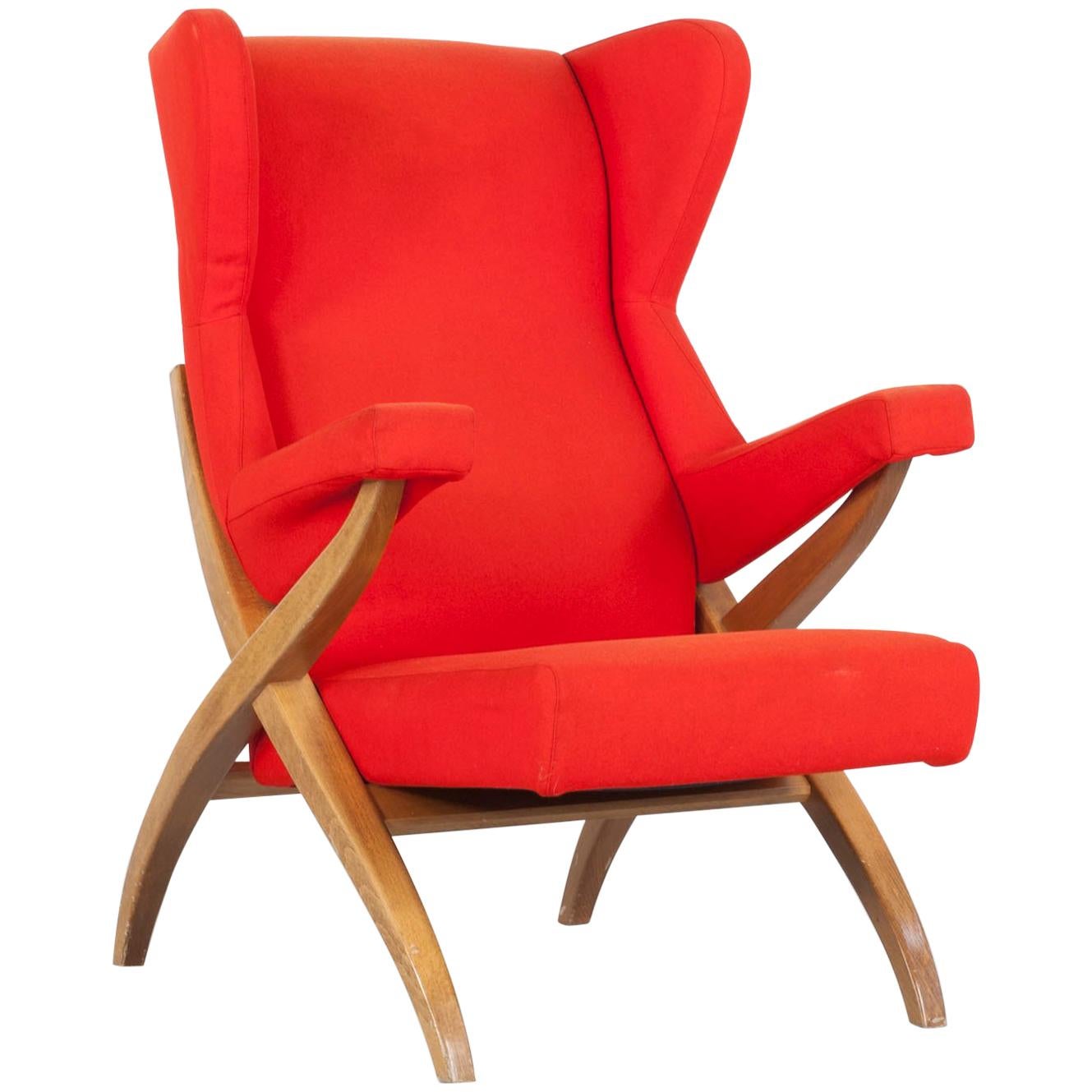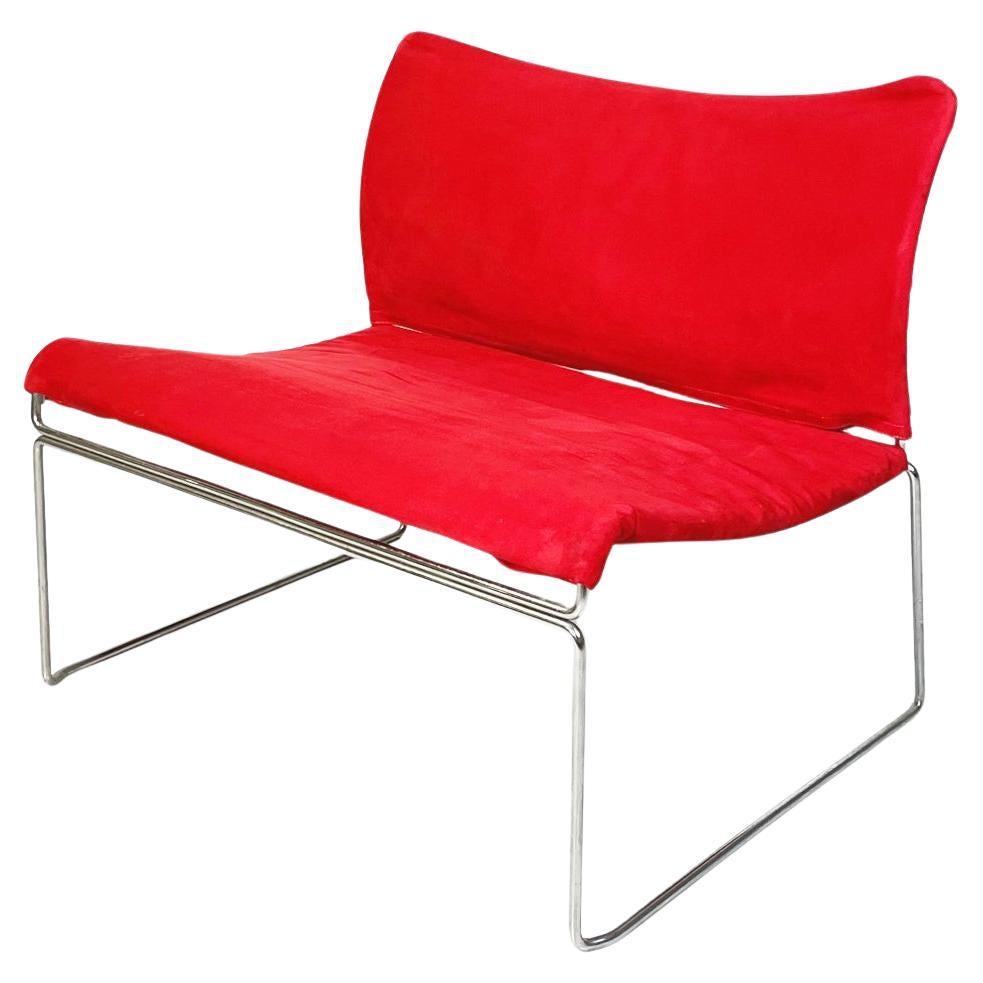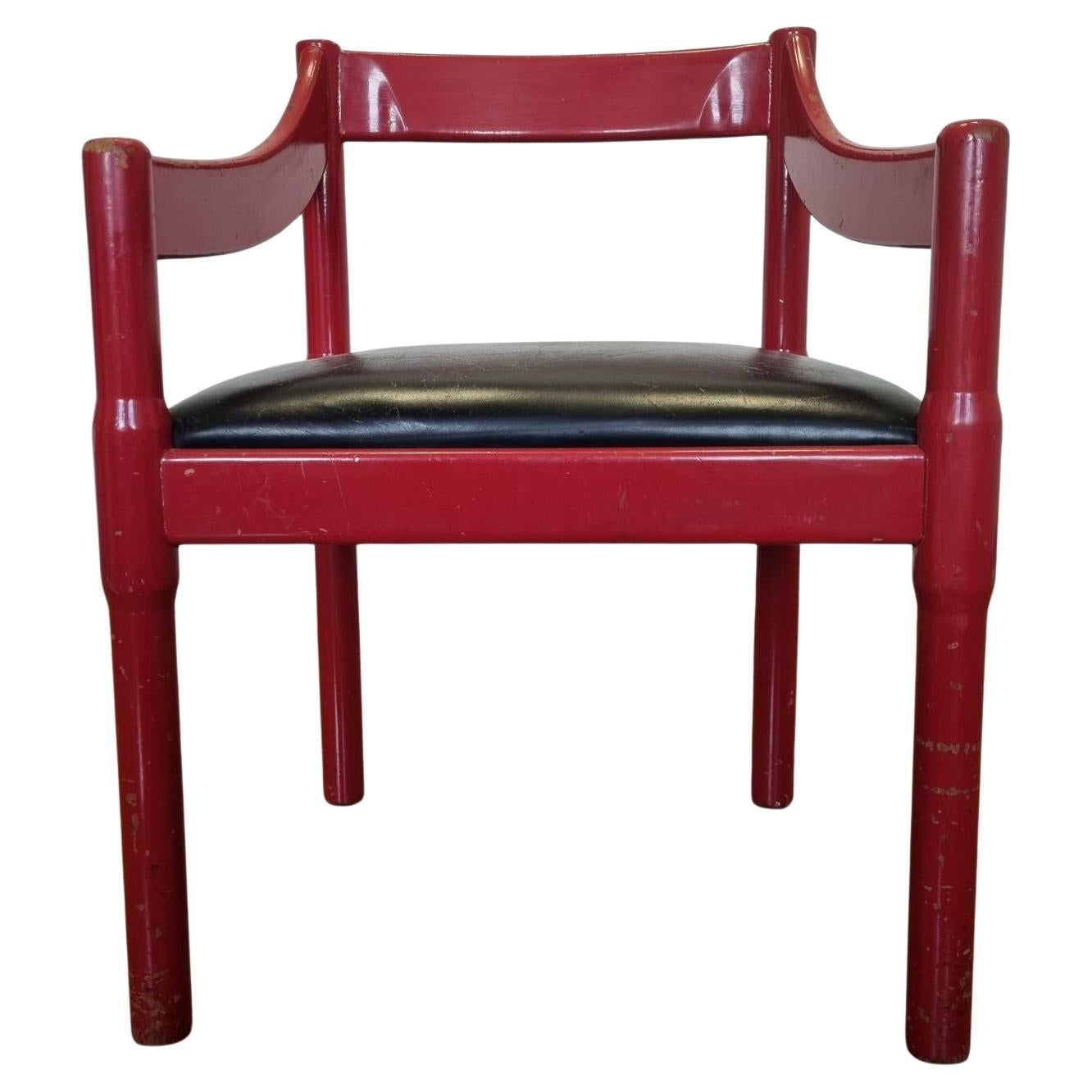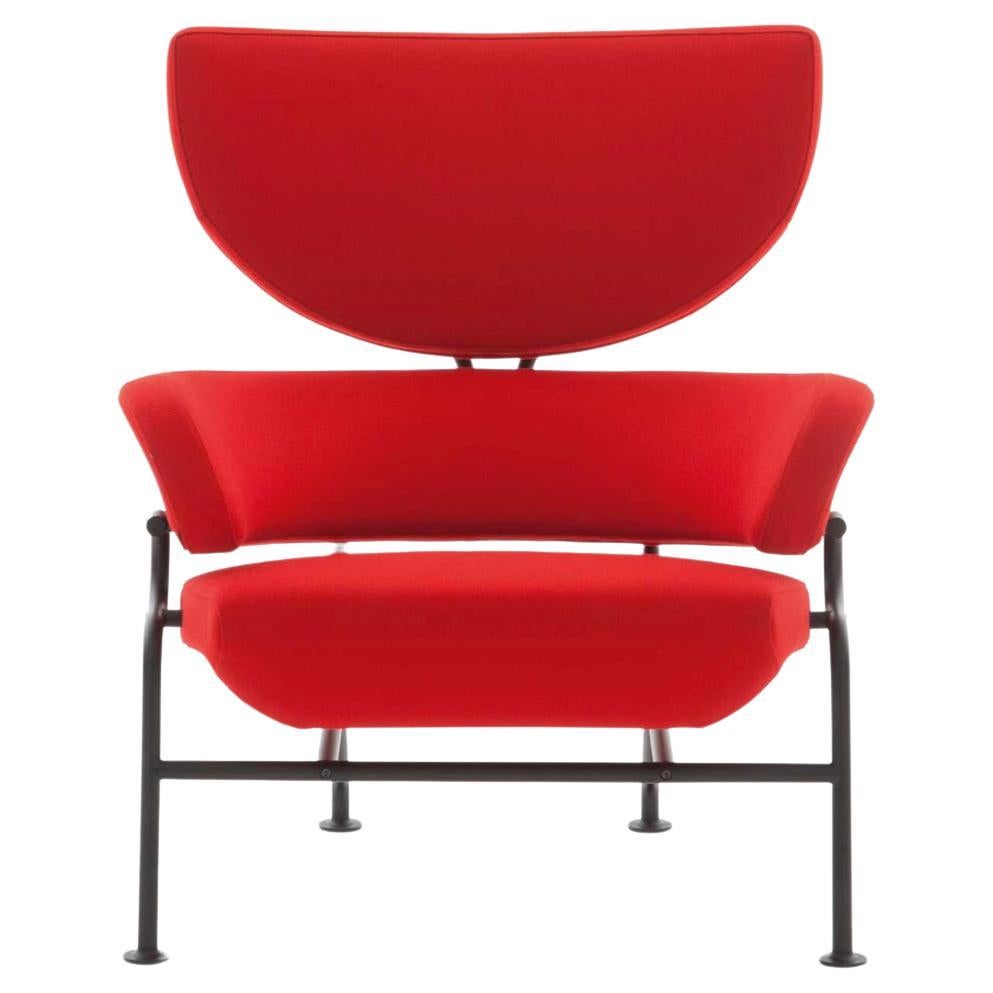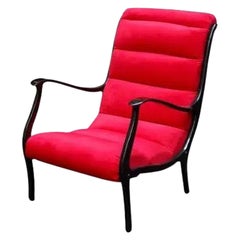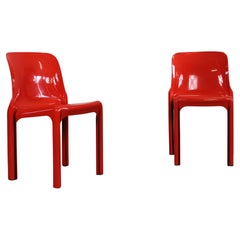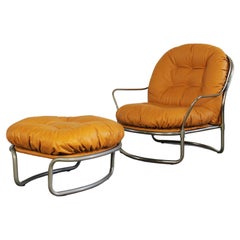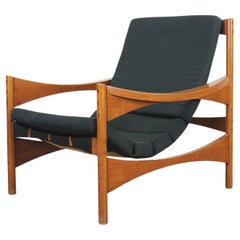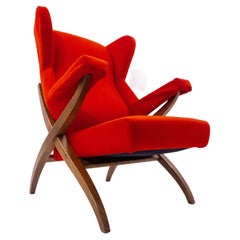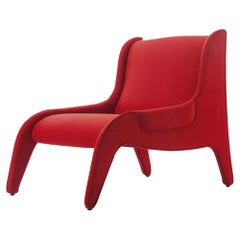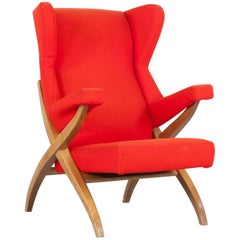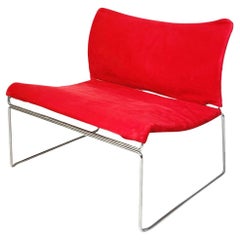Items Similar to Franco Albini PL19 or Tre Pezzi Armchair in Red Fabric by Poggi 1970s
Video Loading
Want more images or videos?
Request additional images or videos from the seller
1 of 11
Franco Albini PL19 or Tre Pezzi Armchair in Red Fabric by Poggi 1970s
$14,347.39
£10,621.40
€12,000
CA$19,853.20
A$21,887.70
CHF 11,450.94
MX$268,521.40
NOK 144,144.61
SEK 134,798.01
DKK 91,408.64
About the Item
PL19 or Tre Pezzi armchair with frame in black lacquered tubular steel, seat and back in padded red fabric.
Designed by Franco Albini and Franca Helg in 1959 for the Nuove terme Luigi Zoja in Salsomaggiore, Italy, and produced by Poggi, Pavia between 1964-70.
The PL19 armchair was exhibited at the XII Triennale of Milan in the 1960.
After spending his childhood and part of his youth in Robbiate in Brianza, where he was born in 1905, Franco Albini moved with his family to Milan. Here he enrolled in the Faculty of Architecture of the Polytechnic and graduated in 1929. He starts his professional activity in the studio of Gio Ponti and Emilio Lancia, with whom he collaborates for three years. He probably had his first international contacts here
In those three years, the works carried out are admittedly of a twentieth-century imprint. It was the meeting with Edoardo Persico that marked a clear turning point towards rationalism and the rapprochement with the group of editors of “Casabella”.
The new phase that that meeting provoked starts with the opening of the first professional studio in via Panizza with Renato Camus and Giancarlo Palanti. The group of architects began to deal with public housing by participating in the competition for the Baracca neighborhood in San Siro in 1932 and then creating the Ifacp neighborhoods: Fabio Filzi (1936/38), Gabriele D’Annunzio and Ettore Ponti (1939).
Also in those years Albini worked on his first villa Pestarini.
But it is above all in the context of the exhibitions that the Milanese master experiments his compromise between that “rigor and poetic fantasy” coining the elements that will be a recurring theme in all the declinations of his work – architecture, interiors, design pieces . The opening in 1933 of the new headquarters of the Triennale in Milan, in the Palazzo dell’Arte, becomes an important opportunity to express the strong innovative character of rationalist thought, a gym in which to freely experiment with new materials and new solutions, but above all a “method”.
Together with Giancarlo Palanti, Albini on the occasion of the V Triennale di Milano sets up the steel structure house, for which he also designs the ‘furniture. At the subsequent Triennale of 1936, marked by the untimely death of Persico, together with a group of young designers gathered by Pagano in the previous edition of 1933, Franco Albini takes care of the preparation of the exhibition of the house, in which the furniture of three types of accommodation. The staging of Stanza per un uomo, at that same Triennale, allows us to understand the acute and ironic approach that is part of Albini, as a man and as a designer: the theme addressed is that of the existenzminimum and the reference of the project is to the fascist myth of the athletic and sporty man, but it is also a way to reflect on low-cost housing, the reduction of surfaces to a minimum and respect for the way of living.
In that same year Albini and Romano designed the Ancient Italian Goldsmith’s Exhibition: vertical uprights, simple linear rods, design the space. A theme, that of the “flagpole”, which seems to be the center of the evolution of his production and creative process. The concept is reworked over time, with the technique of decomposition and recomposition typical of Albinian planning: in the setting up of the Scipio Exhibition and of contemporary drawings (1941) the tapered flagpoles, on which the paintings and display cases are hung, are supported by a grid of steel cables; in the Vanzetti stand (1942) they take on the V shape; in the Olivetti store in Paris (1956) the uprights in polished mahogany support the shelves for displaying typewriters and calculators. The reflection on this theme arises from the desire to interpret the architectural space, to read it through the use of a grid, to introduce the third dimension, the vertical one, while maintaining a sense of lightness and transparency.
The flagpole is found, however, also in areas other than the exhibition ones. In the apartments he designed, it is used as a pivot on which the paintings can be suspended and rotated to allow different points of view, but at the same time as an element capable of dividing spaces. The Veliero bookcase, built in a single prototype in 1940, has two main uprights, made up of slender curved and juxtaposed bars, linked by a complex tensile structure. The lightened upright is also found in the LB7 bookcase, produced by Poggi in the 1950s.
Like the evolution of the upright, also the decomposition and recomposition of the architectural elements and the use of the module, constitute the elements of a method that tends to simplify the complex phenomena of design down to the essential nuclei.
Albini is a complete designer, whose work ranges from construction to design, from installations to urban planning. Among his masterpieces are: the Genoese Museums that change the way the public uses the work of art, the Pirovano Refuge in Cervinia, the Rinascente in Rome and the Milan Metro, which inspires the projects of the New York and Sao Paulo.
Silent, rigorous, ironic man, Albini works incessantly, supported by a moral code that accompanies him throughout his career. He firmly believes in the social role of the architect as a profession at the service of the people. He considers it the very reason for its existence.
- Creator:Poggi (Manufacturer),Franco Albini and Franca Helg (Designer)
- Dimensions:Height: 36.23 in (92 cm)Width: 33.08 in (84 cm)Depth: 28.35 in (72 cm)Seat Height: 16.15 in (41 cm)
- Style:Mid-Century Modern (Of the Period)
- Materials and Techniques:
- Place of Origin:
- Period:
- Date of Manufacture:1970s
- Condition:Wear consistent with age and use.
- Seller Location:Montecatini Terme, IT
- Reference Number:1stDibs: LU5304238995962
About the Seller
4.9
Vetted Professional Seller
Every seller passes strict standards for authenticity and reliability
1stDibs seller since 2020
125 sales on 1stDibs
Typical response time: 1 hour
- ShippingRetrieving quote...Shipping from: Borgo a Buggiano, Italy
- Return Policy
Authenticity Guarantee
In the unlikely event there’s an issue with an item’s authenticity, contact us within 1 year for a full refund. DetailsMoney-Back Guarantee
If your item is not as described, is damaged in transit, or does not arrive, contact us within 7 days for a full refund. Details24-Hour Cancellation
You have a 24-hour grace period in which to reconsider your purchase, with no questions asked.Vetted Professional Sellers
Our world-class sellers must adhere to strict standards for service and quality, maintaining the integrity of our listings.Price-Match Guarantee
If you find that a seller listed the same item for a lower price elsewhere, we’ll match it.Trusted Global Delivery
Our best-in-class carrier network provides specialized shipping options worldwide, including custom delivery.More From This Seller
View AllEzio Longhi Mitzi Armchair in Black Wood and Red Velvet for Elam Italy 1950s
By Elam, Ezio Longhi
Located in Montecatini Terme, IT
Mid-century modern Mitzi armchair with a black ebonized wooden structure, seat, and, back upholstered with a bright red velvet.
Designed by the Italian designer Ezio Longhi for E...
Category
Vintage 1950s Italian Mid-Century Modern Armchairs
Materials
Velvet, Wood
Vico Magistretti Set of Two Red Selene Chairs by Artemide 1970s
By Vico Magistretti, Artemide
Located in Montecatini Terme, IT
A set of two Selene stackable chairs in red resin reinforced with fiberglass, designed by Vico Magistretti in 1967 and produced by Artemide Milano in the 1970s.
The Selene chair was designed in 1967 by Magistretti to be produced in a plastic material, as he affirmed: "The seat and the back are simple curved surfaces. For me, the legs represented the real image of the piece, with as small a volume as that of any common wooden chair. I solved it by exploiting the molding of a plastic material formed by a simple 3-millimeter-thick sheet with a simple but very resistant "S" cross-section which inter-related the object with ordinary chairs without however the elephant legs so untypical of chairs. It was fun working with the model maker on the wood model." When produced in series, "a unit comes out of the machine every five minutes": Selene is the fruit of a single compression molding process on a pre-impregnated sheet (Ottagono 15 / 1969). Magistretti solves the problem of leg resistance by adopting an "S-shaped" configuration that confers resistance to a sheet only 3 millimeters thick. The formal and structural solution had already been previously adopted for the Chimera lamp (a self-supporting methacrylate sheet) and in developing the legs of the Demetrio table...
Category
Vintage 1970s Italian Mid-Century Modern Chairs
Materials
Plastic, Rubber
Carlo de Carli 915 Armchair with Footrest in Metal and Leather by Cinova 1970s
By Carlo De Carli
Located in Montecatini Terme, IT
Set composed by a 915 armchair with a footrest both pieces are made in chromed metal and padded leather.
This set was designed by Carlo de Carli and produced by Cinova in the 1970s.
...
Category
Vintage 1970s Italian Mid-Century Modern Lounge Chairs
Materials
Metal
Franco Bettonica P 40 Armchair in Walnut and Fabric by Poltronova 1960s
By Franco Bettonica, Poltronova
Located in Montecatini Terme, IT
P 40 armchair with structure in walnut wood, the seat and back are composed of a removable padded cushion covered with fabric and sustained by a fabric structure directly attached to...
Category
Vintage 1950s Italian Mid-Century Modern Armchairs
Materials
Fabric, Walnut
Tobia & Afra Scarpa Armchair in Wood and Padded Leather by Maxalto 1975
By Afra & Tobia Scarpa, Maxalto
Located in Montecatini Terme, IT
A single armchair with a frame in wood and cushions upholstery with leather (cognac shade) designed by Tobia and Afra Scarpa and manufactured by Maxalto from the Artona series 1975 c...
Category
Vintage 1970s Italian Mid-Century Modern Armchairs
Materials
Leather, Wood
Gaetano Pesce Nobody's Perfect Small Chair in Red Resin by Zerodisegno 2000s
By Gaetano Pesce, Zerodisegno
Located in Montecatini Terme, IT
Small chair in red and black resin from the Nobody's Perfect series designed by Gaetano Pesce and produced by Zerodisegno 2002.
With the manufacturer's brand stamped on the back side.
Gaetano Pesce is a prominent contemporary Italian designer and architect known for his bold experimentation with materials and color. Throughout his career, he has collaborated with some of Italy's leading design companies, including Artemide, Vitra, Cassina, and B&B Italia.
Born in 1939 in La Spezia, near Genoa, Pesce enrolled at the University of Venice in 1959 to study architecture and graduated in 1965. During the final years of his studies, he also participated in courses at the Venice College of Industrial Design, where he was influenced by distinguished faculty members like Ernesto Nathan Rogers and Mario Bellini. Encouraged by their teachings to embrace innovation in modern design, Pesce became involved with an avant-garde architectural collective called “Gruppo N,” which drew inspiration from the streamlined aesthetics of the Bauhaus.
These diverse inspirations equipped Pesce to embrace contemporary materials and explore the forms they enabled. His designs range from small decorative objects to large architectural spaces and reflect deep contemplation of the modern era. Notable works include his iconic La Mamma chair...
Category
Early 2000s Italian Modern Chairs
Materials
Resin
You May Also Like
Mid-Century Modern Red Armchair Fiorenza by Franco Albini for Arflex, Italy
By Franco Albini
Located in Brussels, BE
Mid-Century Modern Armchair Fiorenza by Franco Albini for Arflex, Italy.
Category
Vintage 1950s Italian Mid-Century Modern Armchairs
Materials
Fabric, Wood
Marco Zanuso Antropus Armchair for Cassina, Italy, in red
By Cassina, Marco Zanuso
Located in Berlin, DE
Armchair designed by Marco Zanuso in 1949, relaunched in 2015. Manufactured by Cassina in Italy. Prices vary dependent on the chosen material.
Category
21st Century and Contemporary Italian Mid-Century Modern Lounge Chairs
Materials
Fabric
Armchair "Fiorenza" in Original Red Color, by Franco Albini in 1952 for Arflex
By Franco Albini, Arflex
Located in Wolfurt, AT
This pair of Italian "Fiorenza" armchairs was designed by Franco Albini for Arflex. The elegantly shaped wooden frame supports the furniture body, which is covered with the original ...
Category
Vintage 1950s Italian Mid-Century Modern Armchairs
Materials
Fabric, Wood
Italian Modern Red Armchair Mod. Saghi by Kazuhide Takahama for Gavina, 1970s
By Gavina, Kazuhide Takahama
Located in MIlano, IT
Italian modern Red armchair mod. Saghi by Kazuhide Takahama for Gavina, 1970s
Iconic and elegant armchair mod. Saghi with steel ...
Category
Vintage 1970s Italian Modern Armchairs
Materials
Steel
Mid-Century Red Carimate Armchair by Vico Magistretti for Cassina, Italy, 60s
By Vico Magistretti, Cassina
Located in Lucija, SI
Mid Century armchair Carimate designed by Vico Magistretti for Cassina in Italy in the 60s
Made of solid wood and leather in good vintage condition with traces of use and age on the...
Category
Vintage 1960s Italian Mid-Century Modern Armchairs
Materials
Leather, Wood
Franco Albini Tre Pezzi Armchair for Cassina
By Franco Albini, Cassina
Located in Berlin, DE
Prices vary dependent on the material.
In 1959, working with Franca Helg, his long-time assistant, Franco Albini designed Tre Pezzi, a contemporary restatem...
Category
21st Century and Contemporary Italian Mid-Century Modern Armchairs
Materials
Metal
$12,195 / item
More Ways To Browse
Olivetti Calculator
Franco Albini Pl19
Committee Armchair
Curved Danish Armchair
Daf Chair
Dan Johnson Viscount
Darmstadt Furniture
De Sede Ds 55
Deep Button Armchair
Don Pettit For Knoll
Dude Ranch
E G Punnett
Eames Chairs Walnut Legs
Empire Style Fauteuils
English Georgian Arm Chairs
English Tub Chair
Equipale Mexican Furniture
Erik Buch Captain


